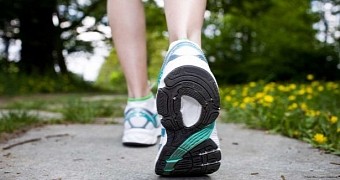You'd think that, what with millions of years of evolution behind us, we'd have walking all figured out by now. As it turns out, we're kind of doing it wrong. Well, not so much wrong as not as efficiently as we could, at least not when it comes to how much energy we use to complete this simple task.
In a paper published in yesterday's issue of the journal Nature, researchers at the North Carolina State University in the US describe a novel exoskeleton that promises to turn us into better walkers by catapulting us off the ground with just enough force to reduce strain on our muscles.
The exoskeleton needs no batteries, is surprisingly lightweight
As detailed in the video below, the exoskeleton developed by North Carolina State University scientists in partnership with Carnegie Mellon University researchers employs a spring and a clutch system to replicate the action of the Achilles' tendon.
The clutch serves to engage the spring when the foot rests on the ground. Specifically, it helps the spring store elastic energy. When the foot is raised off the ground, the elastic energy is released, essentially catapulting the person wearing the exoskeleton.
Since its working principles boil down to storing and releasing elastic energy, the exoskeleton does not need batteries or any other power source to function. On the contrary, a foot placed firmly on the ground is more than enough to get it going.
“The unpowered exoskeleton is like a catapult,” says North Carolina State University scientist Gregory Sawicki. “It has a spring that mimics the action of your Achilles' tendon and works in parallel with your calf muscles to reduce the load placed upon them,” he further details.
The odd-looking lower-leg device weighs 0.5 kilograms (about 1.1 pounds). In a series of experiments, it was shown to reduce energy consumption when walking by an average 7%, which is the equivalent of taking off a 4.5-kilogram (10-pound) backpack.
The exoskeleton could especially benefit the military, stroke victims
The scientists who designed and put together the exoskeleton imagine it being used by the military, especially during times when they have to cover long distances on foot, and by people left impaired by a stroke or some other medical issue.
Otherwise perfectly healthy individuals having trouble getting around simply because of old age could also find it useful, specialist Gregory Sawicki and his colleagues explain. The same goes for people who have a soft spot for hiking or other pastimes that strain the body.
“Someday soon we may have simple, lightweight and relatively inexpensive exoskeletons to help us get around, especially if we’ve been slowed down by injury or aging,” says Carnegie Mellon University researcher and study co-author Steven Collins.

 14 DAY TRIAL //
14 DAY TRIAL // 